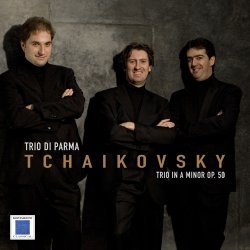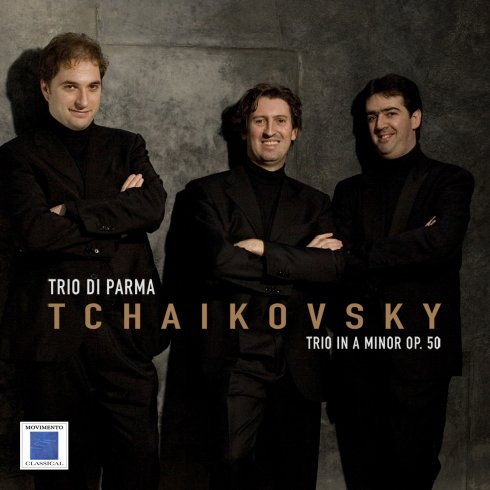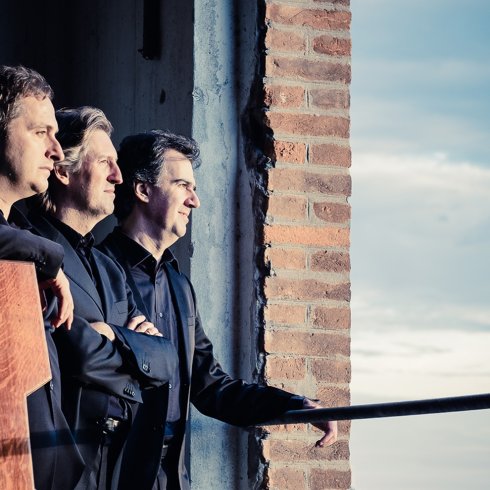

Masterpiece of his maturity as well as a work of considerable proportions, the Trio in A minor dates back to the two-year period 1881-82 and it is Cjcovskkij’s only work conceived for this staff. A couple of years earlier, in a letter to Nadežda von Meck - singular Gigure of inspirational muse and patron who had a central role in gestation not a few works - the Russian musician had expressed his aversion for such a chamber genre. To the woman, who asked him why not had still undertaken the composition of a trio with piano and indeed implicitly asked him to draft it, Tchaikovsky declared that he could not fulGill that polite request “as this goes beyond mine possibility “. Obviously, the composer was certainly not lacking in skills on the purely technical level: he declared in fact his extraneousness to that type training for timbre reasons. “Perhaps by the very nature of mine hearing - the musician speciGied in that letter dated October 1880 – for me the association of the piano with the violin and the cello is unbearable “: The hypersensitive Tchaikovsky also asserted - with a hint of ill-concealed snobbery intellectual to have doubts about the possibility for the three instruments of amalgamate, “so that it is a real torment for me to listen to a trio”. Wondering how there could exist «homogeneity between stringed instruments and the piano “he then added again with a quid of provocative esprit:”
The trio with piano has always something artiGicial ”, since“ each of the three instruments Plays, not what suits his natural character, but what he does the composer himself dictates. And the composer, very often, comes with difGiculty to distribute the different parts of its composition among the individual instruments ». Of course, being a cultured and intelligent man, Tchaikovsky was not ignorant at all about the existence of “many trios of great musical value” which have long been stable in the repertoire, but ultimately he ended up peremptorily admitting “not to love the Trio as a form ». Nevertheless, he then radically changed his opinion and in November 1881 he wrote to his eccentric benefactress to announce her the intention to measure himself precisely with that form he had considered foreign to his own horizons: it happened during a stay in Italy together with his brother Modest. «When you know, dearest, what I am now composing, you will remain astonished, “Tchaikovsky wrote to von Meck. «I suddenly decided to venturing into this Gield from which I had so far kept away from. The beginning of the trio is already sketched ... I hope with all my soul that I can do it... “. To doubts and all pessimism took over a singular creative fervor; Tchaikovsky continued with it quickly drafted working very hard so that the Trio was completed in January of the following year in Rome. The premiere took place at the Moscow Conservatory on March 23 of that same 1882, in the course of a commemoration ceremony for Nikolaj Rubinštejn (at one year from early death), former director of the same Institute and very popular composer, towards whom Tchaikovsky nurtured sincere friendship and deep gratitude,
despite some contrasts: therefore the dedication of the Trio in A minor to the illustrious pianist, self teacher and conductor - even more, ‘A la mé moire d’un grand Artist ‘- appears not only legitimate, but almost a kind of reconciliation posthumously for those disagreements that only partially clouded an intense mutual respect relationship. It was the publisher Jurgenson who published the Trio at the end of 1882. At the Girst execution of the demanding work - which happened privately and in the absence of the Author - the violinist Jan Hrimaly took part, the cellist Wilhelm Fitzenhagen (dedicatee of the Rococo Variations) and the pianist Sergej Taneev. The latter declared that he had been studying it “for six hours a day for more than three weeks’: due to the complexity of the part piano is not difGicult to believe. But also from the formal point of view the Trio reveals not a few reasons of interest, starting with the unusual coinage in only two vast movements lasting a total of about Gifty minutes. The trio therefore opens with an elegiac piece in the regime of Moderato molto – perhaps one of the pinnacles of his inspiration - whose painful expressiveness well reGlects the regret for the recent disappearance in Paris of the oldest friend and colleague. (Tchaikovsky had been reached by the terrible news while he was in Nice and immediately rushed to the capital city to attend the funeral at the orthodox church of rue Daru). It is the cello that starts the page, exposing a theme steeped in afGliction, immediately picked up by the violin - and destined to reappear in closing del Trio - while the piano spreads an arabesque festoon of arpeggios in quavers. The page becomes stormy almost immediately culminating in an Allegro giusto from the iterated chords. Then it calms down by lingering in the cantabile, then one emerges a splinter of Adagio with grief and again revives. In the section of the development prevails a certain excitement, passionate areas alternate in fact to some areas of greater relaxation. At times the piece takes on a thickness almost symphonic, but at the end it regains the exhausted and languid climate of the beginning, giving moments of undeniable suggestion. The second movement, in form of variations, opens with a cantabile theme, almost a romance without words set in the clear key in E major; an aura of calm serenity, destined to persist even in the Girst variation, is released immediately, animated and sliding, where the latter sees the violin part wrinkle. Crackling, almost humorous, the third part is punctuated by pizzicati and delicious arpeggios pianistic, in antithesis with the following one (in C sharp minor) crossed by a thrill of nostalgia. If the Gifth (in C sharp major) presents iridescent carillon sounds and a faint naive halo, the next is a lovely waltz, harmonically mottled, close to certain passages of the Serenade for strings op. 48.
An epic tone, sometimes chivalrous, emerges in the seventh from the vigorous chordal concatenations, then yielding to a real Fugue (octave variation) with solid writing and robust sonorities, Ginally sealed by a triumphant coda. By contrast, the ninth (Andante febile) is dreamy; the violin exhales heartfelt sighs while dialoguing with the cello on the liquescent arpeggios pianistic. Then the conversations break off gently leading to the tenth variation, a pressing Mazurka in the remote key of A Glat from the vague Chopinian echoes, then the eleventh, in amber colours, reveals a delicate lyricism, Ginally fading on remote strokes.
With the twelfth article variation begins the concluding part of the movement (Finale and Coda), almost a separate block, according to the author’s indication. Scanning is very fast, almost a virtuoso perpetuum mobile, the atmosphere is on Gire, visionary as in certain pages of Schumann, so that every single cell seems feeding on an euphoric intoxication. Then unexpectedly, here it is re-presents the theme of the initial movement, proclaimed in full voice; writing it increasingly enhances the exasperated anguish and the sense of tragic fatalism. Thirteen more bars (Lugubre) intervene to conclude the superb Trio: a real funeral march with implacable piano accords, on which violin and cello whisper their disheartened appeal, destined to remain unanswered. Before concluding, it is worth mentioning how, at the time of publication, the Author himself has authorized two possible ‘cuts’ per second and very large movement assuming the suppression of the entire eighth variation (perhaps not entirely satisGied with the polyphonic conduct) and fourteen out of thirty pages total within the Ginal Variation and Coda which can therefore start, optionally, from recovery.


TRIO DI PARMA
Alberto Miodini Piano - Ivan Rabaglia Violin - Enrico Bronzi Cello
The “Trio di Parma” was formed in 1990 in the chamber music class of Pierpaolo Maurizzi at the "A. Boito" Conservatory of Parma. Subsequently the Trio deepened its musical education with the legendary “Trio di Trieste“ at the School of Music of Fiesole and the Accademia Chigiana of Siena. In 2000, the trio was chosen to participate in the Isaac Stern Chamber Music Workshop at Carnegie Hall in New York City.
The Trio di Parma has received the most prestigious awards with the successes at the International Competition "Vittorio Gui" in Florence, at the International Competition of Chamber Music in Melbourne, at the Munich’s ARD International Competition and at the International Competition of Chamber Music in Lyon. In 1994, the Italian National Association of Music Critics awarded the “Trio di Parma” the "Premio Abbiati" as the best chamber ensemble. The “Trio di Parma” has been invited by the most important musical institutions in Italy (Accademia S.Cecilia in Rome, Società del Quartetto in Milan, Amici della Musica in Florence, Gran Teatro La Fenice in Venice, Unione Musicale in Turin, GOG in Genova, Amici della Musica in Palermo, Accademia Filarmonica Romana...) and abroad (Berlin Philharmonic, Carnegie Hall and Lincoln Center in New York, Wigmore Hall in London, Konzerthaus in Vienna, Moliere Hall in Lyon, St. Petersburg Philharmonic, Colon Theatre and Coliseum in Buenos Aires, Los Angeles, Washington, Hamburg, Munich, Dublin, Warsaw, London, Rio de Janeiro, São Paulo, Lockenhaus Festival, Barossa and Melbourne Festival, Orta Festival...).
The trio has collaborated with important musicians such as Vladimir Delman, Carl Melles, Anton Nanut, Bruno Giuranna, Simonide Braconi, Alessandro Carbonare, Eduard Brunner and Guglielmo Pellarin; and has made radio and television recordings for RAI and for numerous foreign broadcasters (Bayerischer Rundfunk, NDR, WDR, MDR, Radio Bremen, ORT, BBC Londra, ABC-Classic Australia).
The trio has also recorded the complete works of Brahms for UNICEF, Beethoven and Ravel for the magazine Amadeus, Schostakovich for the Stradivarius label (awarded as best album of the year 2008 by the magazine “Classic Voice”) Pizzetti, Liszt, Schumann and Dvorak for the Concerto label and Schubert for the Decca label, Tchikovsky "Trio in A minor , Op.50 " for the “Movimento Classical” label (directed by Raffaele Cacciola).
The members of the “Trio di Parma” have a constant educational commitment in the Conservatories of Novara, at the Mozarteum in Salzburg and at the Conservatory of Parma where the Trio also holds a Master of High Specialization in Chamber Music. Ivan Rabaglia plays a Santo Serafino built in Venice in 1740 (courtesy of Fondazione Pro Canale onlus) and Enrico Bronzi a Vincenzo Panormo built in London in 1775.
